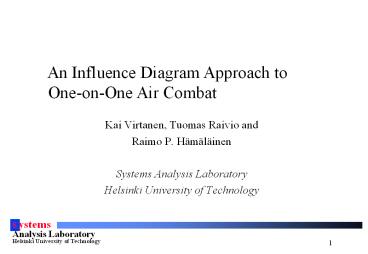Kai Virtanen, Tuomas Raivio and - PowerPoint PPT Presentation
Title: Kai Virtanen, Tuomas Raivio and
1
An Influence Diagram Approach to One-on-One
Air Combat
- Kai Virtanen, Tuomas Raivio and
- Raimo P. Hämäläinen
- Systems Analysis Laboratory
- Helsinki University of Technology
2
Outline
- Maneuvering decisions in one-on-one air combat
- Existing modeling approaches
- Decision analytical maneuvering models
- Influence diagram
- One-on-one air combat game
- Influence diagram for a single maneuvering
decision - Influence diagram game for a single maneuvering
decision - Simulation procedure for solving the game
- Conclusions
3
Maneuvering decisions in one-on-one air combat
¼
tDt
tDt
¼
t0
t0
Outcome depends on all the maneuvers of both the
players Þ Dynamic game problem
Objective Find the best maneuvering sequence with
respect to the overall goals of a pilot! -
Preference model - Uncertainties - Behavior of
the adversary - Dynamic decision environment
4
Existing modeling approaches
- Dynamic game theory
- Pursuit-evasion games
- - fixed roles of the players
- - saddle point solution
- Two-target games
- - qualitative solution, outcome regions in the
state space - - quantitative solution is intractable
- Simple performance criteria
- Lack of realistic uncertainty models
- Game models emulating the decision making of
pilots - Capture the preferences of a pilot
- Short planning horizon
- gt Myopic maneuvering decisions
5
Decision analytical maneuvering models
- Single stage influence diagram model (Virtanen et
al. 1999) - Simulates pilots short-term decision making in
one-on-one air combat - Multistage influence diagram model (Virtanen et
al. 2001) - Determines a preference optimal flight path
against a given trajectory - A new nonlinear programming -based solution
approach - Two new models
- Contain components representing the behavior of
the adversary - stochastically gt traditional influence diagram
- explicit decision variable gt influence diagram
game - Best myopic controls
- Simulation procedure for solving one-on-one air
combat game
6
Influence diagram (ID) (Howard et al. 1984)
- Directed acyclic graphs
- Describes the major factors of a decision problem
- Widely used in decision analytic application
areas
Time precedence
Informational arc
Alternatives available to DM
Decision
Random variables
Conditional arc
Chance
Probabilistic or functional dependence
Deterministic variables
Conditional arc
Deterministic
A utility function
Conditional arc
Utility
7
Influence diagram (continued)
- State of the world is described by attributes
- States are associated with
- Utility
- Probability
- Utility is a commensurable measure for goodness
of attributes - Results include probability distributions over
utility - Decisions based on utility distributions
- Information gathering and updating using Bayesian
reasoning
8
One-on-one air combat game
White
Black
- Evolution of the players states are represented
by a set of difference equations, e.g., point
mass model - Goals of the players
- 1. Avoid being captured by the adversary
- 2. Capture the adversary
- Four possible outcomes
- Maneuvering decisions are represented by an ID
The controls of both the players are selected
such that the expected utilities at each
decision stage are maximized
9
ID for a single maneuvering decision
Solution Discrete controls gt Rollback
procedure Continuous controls gt Nonlinera
programmings
Adversary's Present State
Adversary's Maneuver
Adversarys State
Measurement
Combat State
Present Measurement
Present Combat State
Situation Evaluation
Present State
State
Maneuver
Present Threat Situation Assessment
Threat Situation Assessment
10
ID game for a single maneuvering decision
Solution Discrete controls gt Matrix
game Continuous controls gt Nonlinear programmings
Blacks comprehension
Implies Information Structure
Combat state
White's comprehension
11
Simulation procedure for solving the game
ttDt
Blacks Threat Assessment at t1
Blacks Threat Assessment at t
Blacks Influence Diagram at t
Blacks Control at t
Blacks State at t
Blacks State at t1
Terminate?
Whites State at t1
Whites State at t
Whites Influence Diagram at t
Whites Control at t
Whites Threat Assessment at t
Whites Threat Assessment at t1
ttDt
12
Numerical example
- Symmetric initial state
- Whites aircraft more agile
- Solution generated with the simulation procedure
and the ID game - White wins
Black
White
Altitude, m
X-range, m
Y-range, m
13
Conclusions
- New influence diagram models
- Model human preferences under uncertainty and
multiple competing objectives in one-on-one air
combat - Take into account the rational behavior of the
adversary - Single stage model gt Produce the best myopic
controls, can be calculated in real-time - A new way to produce reprisal strategies in a
two-target game - Utilization
- Planning fighter maneuvers
- Air combat simulators, a good computer guided
aircraft - Future research
- Longer planning horizon gt multistage models
- Open-loop solutions of the multistage one-on-one
air combat game































